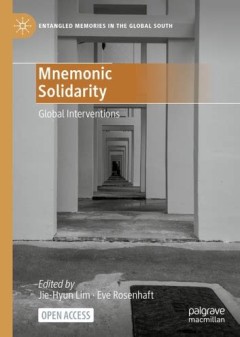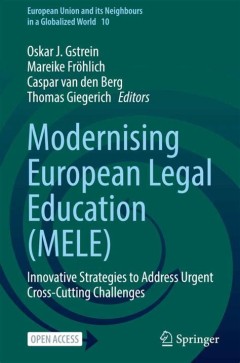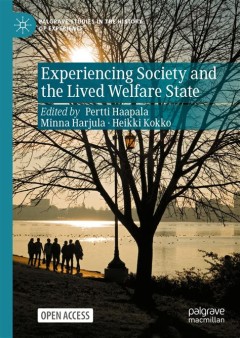Filter by

The Philosophy of Leopold Blaustein: Descriptive Psychology, Phenomenology, a…
Ini adalah buku akses terbuka yang didedikasikan untuk menemukan kembali sejarah awal fenomenologi dalam konfrontasi dengan warisan Franz Brentano dengan membahas filosofi Leopold Blaustein. Buku ini menawarkan perspektif unik tentang sejarah gerakan fenomenologis dengan mempresentasikan perkembangan teori Blaustein. Blaustein adalah seorang filsuf yang dididik oleh Kazimierz Twardowski di Lvov…
- Edition
- 1
- ISBN/ISSN
- 978-3-031-63685-1
- Collation
- online resource ( IX, 325 Pages)
- Series Title
- Sumber-sumber Utama dalam Fenomenologi; Fenomenologi Awal
- Call Number
- 190 PLO p

An Invisible Thread: Heresy, Mass Conversions, and the Inquisition in the Kin…
Author: Stefania Pastore In Toledo in 1529, a converso named Pedro de Cazalla declared that the connection between man and God was but a thread and that it should not be mediated by the Church. Hardly an isolated phenomenon, Cazalla’s inner spirituality was a widespread response to the increasing repression of religious dissent enacted by the Inquisition. Forced baptisms of Jews and Muslims…
- Edition
- Volume: 85
- ISBN/ISSN
- 978-90-04-71423-6
- Collation
- -
- Series Title
- -
- Call Number
- -

Tracing Private Conversations in Early Modern Europe : Talking in Everyday Life
This open access book provides a multifold exploration of how people in early modern Europe understood, conducted, and actively used private conversations. From sharing personal matters to discussing delicate secrets, all layers of early modern society had their motives for wanting to keep certain exchanges out of public eyes and ears, and ways of trying to achieve this. Detecting such instance…
- Edition
- -
- ISBN/ISSN
- 978-3-031-46630-4
- Collation
- XX, 350
- Series Title
- -
- Call Number
- -

Mnemonic Solidarity : Global Interventions
This open access book provides a concise introduction to a critical development in memory studies. A global memory formation has emerged since the 1990s, in which memories of traumatic histories in different parts of the world, often articulated in the terms established by Holocaust memory, have become entangled, reconciled, contested, conflicted and negotiated across borders. As historical act…
- Edition
- 1
- ISBN/ISSN
- 9783030576691
- Collation
- XI, 135 hlm; ill., lamp.,
- Series Title
- -
- Call Number
- -

Supersapientia: Berthold of Moosburg and the Divine Science of the Platonists
This study examines the motivations and doctrinal coherence of the Commentary on the Elements of Theology of Proclus written by Berthold of Moosburg, O.P. († c. 1361/1363). It provides an overview of Berthold’s biography and intellectual contexts, his manuscript remains, and a partial edition of his annotations on Macrobius and Proclus. Through a close analysis of the three prefaces to the …
- Edition
- Volume: 1
- ISBN/ISSN
- 978-90-04-46548-0
- Collation
- -
- Series Title
- -
- Call Number
- -

Common Good and Self-Interest in Medieval and Early Modern Philosophy
Volume akses terbuka ini menyediakan analisis mendalam tentang diskusi filosofis mengenai kebaikan bersama dan hubungannya dengan kepentingan pribadi dalam sejarah filsafat Barat. Ketiga belas bab mengeksplorasi para pemikir terkenal dan kurang dikenal dari Abad Pertengahan hingga abad kedelapan belas, yang juga mencakup latar belakang kuno yang relevan. Dengan menjembatani kesenjangan antara p…
- Edition
- 1
- ISBN/ISSN
- 978-3-031-55304-2
- Collation
- 1 online resource ( XVIII, 286 Pages)
- Series Title
- -
- Call Number
- 190.2 JUH c

Modernising European Legal Education (MELE) : Innovative Strategies to Addres…
This open access book presents innovative strategies to address cross-cutting topics and foster transversal competences. The modernization of European legal education presents a compelling challenge that calls for enhanced interdisciplinary collaboration among academic disciplines and innovative teaching methods. The volume introduces venues towards education innovation and engages with complex…
- Edition
- 1
- ISBN/ISSN
- 9783031408014
- Collation
- VIII, 303 hlm,: ill, lamp;
- Series Title
- -
- Call Number
- -

Lived Institutions as History of Experience
This open access book focuses on institutions that were produced and formed by the emerging welfare state. How were institutions experienced by the people who interacted with them? How did institutions as sites of experience shape and structure people’s everyday lives? Histories of institutions have mainly focused on the structures and power relations produced by institutional settings. Likew…
- Edition
- 1
- ISBN/ISSN
- 9783031389566
- Collation
- XVII, 353 hlm,: ill, lamp;
- Series Title
- -
- Call Number
- -

Experiencing Society and the Lived Welfare State
This open access book presents a new approach to the history of welfare state. By applying the concepts of experiencing society and the lived welfare state, the collection introduces theoretical, methodological and empirical insights for bridging the everyday life and institutional structures. The chapters analyze how the welfare state as a particular individual-society relationship has become …
- Edition
- 1
- ISBN/ISSN
- 9783031216633
- Collation
- XX, 379 hlm,: ill, lamp;
- Series Title
- -
- Call Number
- -

Lived Nation as the History of Experiences and Emotions in Finland, 1800-2000
This open access book uses Finland in the nineteenth and twentieth centuries as an empirical case in order to study the emergence, shaping and renewal of a nation through histories of experience and emotions. It revolves around the following questions: What kinds of experiences have engendered national mobilization and feelings of national belonging? How have political and societal conflicts tu…
- Edition
- 1
- ISBN/ISSN
- 9783030698829
- Collation
- XXI, 392 hlm,: ill, lamp;
- Series Title
- -
- Call Number
- -
 Computer Science, Information & General Works
Computer Science, Information & General Works  Philosophy & Psychology
Philosophy & Psychology  Religion
Religion  Social Sciences
Social Sciences  Language
Language  Pure Science
Pure Science  Applied Sciences
Applied Sciences  Art & Recreation
Art & Recreation  Literature
Literature  History & Geography
History & Geography